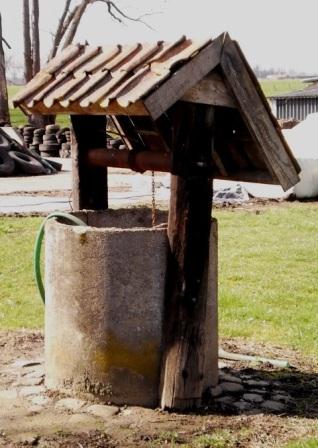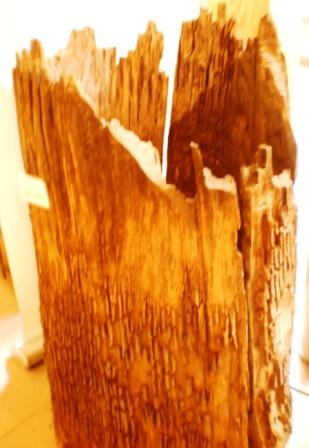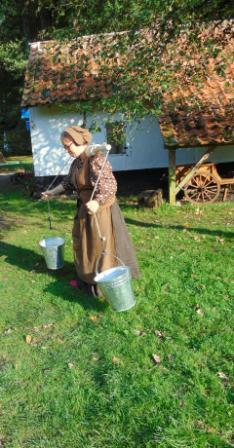 It is heavy and wet work. If it’good. If it stays dry work you’re out of luck. Place a concrete ring on the ground and dig in there and under it all ground away, so you can lower the ring slowly and as straight as possible. If he's in the ground role and move the next ring on top of it and go on digging, until you have enough water. The water makes the soil and the job increasingly heavier, but don’t stop too soon because later the rings slide harder or no longer downward. They will be jammed in the earth..
It is heavy and wet work. If it’good. If it stays dry work you’re out of luck. Place a concrete ring on the ground and dig in there and under it all ground away, so you can lower the ring slowly and as straight as possible. If he's in the ground role and move the next ring on top of it and go on digging, until you have enough water. The water makes the soil and the job increasingly heavier, but don’t stop too soon because later the rings slide harder or no longer downward. They will be jammed in the earth..
If you hit quicksand work can be very dangerous. The digger can disappear completely with the tube in the sand. Pay attention, and at least secure yourself with a rope to a helper atop.
You can get the first heavy concrete ring of the well at the correct place without a crane by making the hole large enough with a sloping inwardly and less deep rotating rollway like (half) a spiral. You dig about half the circumference of the well, a way that’s wider than the ring is high, gradually from the horizontal start position on the ground (start of the rolling position) to the vertical put position upright in the ground. The ring then rolls itself into a good position and stands upright too. The hole should be big enough to tilt the tube upright. With levers you can process further corrections.
In lack of concrete pipes you also can strengthen the sides with braided branches. That will not last very long.
You can also use timber whose cross-section has a trapezoidal shape, so you can put them together like staves of a barrel. The ea rth on the outside will press them together. For the last clapboard you dig extra space so you can wrench it in crosswise and then rotate it in position.
rth on the outside will press them together. For the last clapboard you dig extra space so you can wrench it in crosswise and then rotate it in position.
It is also possible to lay the pit wall downwards with bricks.
Besides for a shelter of turfs our creative ancestors used sods also to strengthen a pit wall. In the Middle Ages they dug in tubs for a barrel pit. And in 1250 people made trunk wells as well. Usually they used hollow trees, or they hollowed an oak to bury. Several of these are recovered.
On the bottom of the pit you should lay at least a double layer of pebbles. That prevents sediment, dust and dirt to swirl and come up in the wells (with bucket) or pumps. Don’t hang the pump inlet floating (and moving), but fixed some distance above the bottom.
To draw water you better use a sink tub. A plastic bucket is light and floats easily. Do not drop the bucket straight down, because it floats on water and won’t easily get filled. Drop him (with a rope to handle itJ) with the opening tilted downward such that a part of the top edge first touches the water surface. The in running water will dip the bucket and fill and sink it quickly. Don’t pull him upright before he is filled, because with some water in he stays floating, and you cannot make him tumble again.
This applies equally well if you have installed a (wooden) roll to wind the rope above the pit.
It takes some practice. Boaters have  no qualms to get their buckets filled that way. But they have more space, and experience.
no qualms to get their buckets filled that way. But they have more space, and experience.
Long stakes were also used to draw with a bowl. Sometimes they were hung on a long lever over a high- pile, with at the other end bricks as a counterweight. You need to have some smooth motion, then it can be done with less effort.
When my well once was polluted by a floating dead mouse, I cleaned it: I emptied and washed it and then scattered some sulfite (also used by brewers to disinfect) in it. Since residual sulfite is permitted in wine, it seemed to me to be a safe idea. But maybe there are better options?
(Better construct your well in a way animals cannot enter it.)
According to archeologieonline.nl (2020), the oldest wooden structure was discovered on the D35 motorway near Ostrov in the Czech Republic. A kind of wooden box at the bottom of a water point turned out to be an even older well. "The trees that were used to saw the boards were cut down about 7275 years ago." (Makes me wonder if there were any saws at that time?) The structure dug up in 2018 consisted of four 1.40 meters long oak corner posts, with wooden planks in between (80 x 80 cm).
Who digs a pit for another is a banker (Hugo Olaerts)
‘He who digs a pit for another self gets backache himself.’(E. Constant Sr.)
